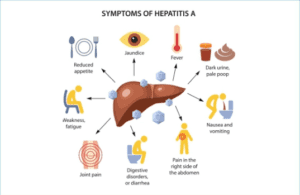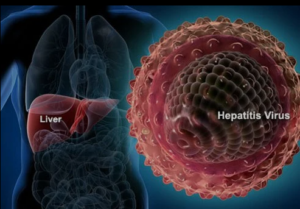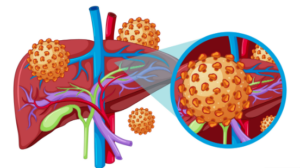Outline of the Article
- Introduction
- Brief overview of hepatitis
- Importance of understanding the disease
- Types of Hepatitis
- Hepatitis A
- Hepatitis B
- Hepatitis C
- Hepatitis D
- Hepatitis E
- Causes and Transmission
- Viral infection
- Contaminated food and water
- Blood-to-blood contact

- Symptoms and Signs
- Jaundice
- Fatigue
- Abdominal pain
- Nausea and vomiting
- Diagnosis
- Blood tests
- Imaging tests
- Liver biopsy
- Treatment Options
- Antiviral medications
- Liver transplant
- Supportive care
- Prevention Measures
- Vaccination
- Safe practices in food handling
- Safe sex practices
- Global Impact
- Worldwide prevalence
- Socioeconomic factors influencing hepatitis
- Living with Hepatitis
- Coping strategies
- Support groups
- Challenges in Hepatitis Management
- Access to treatment
- Stigma and discrimination
- Latest Research and Innovations
- Breakthroughs in hepatitis treatment
- Ongoing research efforts
- Hepatitis Awareness Campaigns
- Importance of education
- Role of communities
- Myths and Facts About Hepatitis
- Dispelling common misconceptions
- The Future of Hepatitis Control
- Advances in prevention
- Global initiatives
- Conclusion
- Recap of key points
- Encouragement for awareness and prevention
Hepatitis: Unraveling the Mystery of a Silent Threat
Hepatitis, a term that strikes a chord of concern in the medical world, encompasses a range of liver inflammations caused by viral infections. From Hepatitis A to Hepatitis E, each type presents unique challenges and considerations for both individuals and healthcare systems. In this article, we’ll delve into the different aspects of hepatitis, from its types and causes to diagnosis, treatment, and preventive measures.
Introduction
Understanding hepatitis is crucial in safeguarding our health. Hepatitis is not just a singular disease but a family of viruses that can lead to liver inflammation. The severity of the condition varies, and in some cases, it can progress to chronic liver disease or even liver cancer.
Types of Hepatitis
Hepatitis A
Hepatitis A is often associated with contaminated food or water and is preventable through vaccination.
Hepatitis B
This type is primarily transmitted through blood and body fluids, making it a significant concern for healthcare workers and individuals engaging in unprotected sex.
Hepatitis C
Mainly spread through blood-to-blood contact, Hepatitis C can lead to chronic liver diseases and requires early detection for effective treatment.
Hepatitis D
This type only affects individuals who are already infected with Hepatitis B, emphasizing the importance of prevention strategies.
Hepatitis E
Commonly transmitted through contaminated water, Hepatitis E can have severe outcomes, especially in pregnant women.
Causes and Transmission
Hepatitis is mainly caused by viral infections. Contaminated food and water, blood-to-blood contact, and unprotected sex are common modes of transmission.
Symptoms and Signs
Recognizing the symptoms of hepatitis is vital for early intervention. Jaundice, fatigue, abdominal pain, and nausea are common signs that should not be ignored.
Diagnosis
Accurate diagnosis involves blood tests, imaging tests, and, in some cases, a liver biopsy to assess the extent of damage.
Treatment Options
Antiviral medications, liver transplants, and supportive care are among the treatment options for managing hepatitis, with the choice depending on the type and severity of the infection.
Prevention Measures
Vaccination, safe food handling practices, and safe sex practices play a crucial role in preventing the spread of hepatitis.
Global Impact
Hepatitis is a global health concern with varying prevalence rates. Socioeconomic factors contribute to the challenges in managing and preventing the disease.
Living with Hepatitis
Coping with hepatitis involves adopting lifestyle changes and seeking support from healthcare professionals and support groups.
Challenges in Hepatitis Management
Access to treatment and the stigma associated with hepatitis pose significant challenges in effective disease management.
Latest Research and Innovations
Ongoing research efforts and breakthroughs in treatment options offer hope for better outcomes in hepatitis management.
Hepatitis Awareness Campaigns
Education and community involvement are key components in raising awareness and promoting preventive measures against hepatitis.
Myths and Facts About Hepatitis
Dispelling common misconceptions surrounding hepatitis is essential for accurate understanding and prevention.
The Future of Hepatitis Control
Advances in prevention strategies and global initiatives aim to reduce the burden of hepatitis on a global scale.
Conclusion
In conclusion, hepatitis is a multifaceted health concern that demands attention and proactive measures. Understanding the types, causes, and prevention strategies is crucial for individuals and communities to safeguard their health and well-being.
FAQs About Hepatitis
- Can Hepatitis be completely cured?
- While some types of hepatitis can be cured, others may require lifelong management.
- How effective are hepatitis vaccines?
- Hepatitis vaccines are highly effective in preventing infection and its complications.
- Is hepatitis only transmitted through blood?
- No, hepatitis can also be transmitted through contaminated food, water, and unprotected sex.
- Are there any natural remedies for hepatitis?
- While lifestyle changes can support liver health, medical intervention is crucial for managing hepatitis.
- What role do communities play in hepatitis prevention?
- Communities play a vital role in raising awareness, dispelling myths, and promoting preventive measures.

